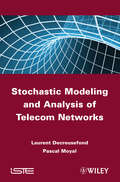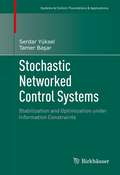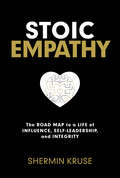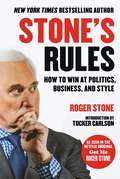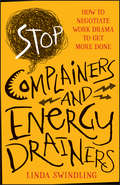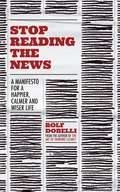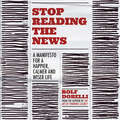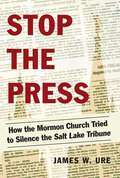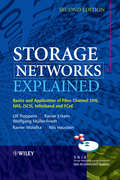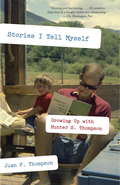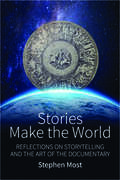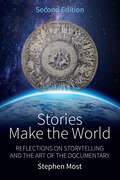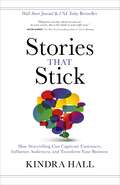- Table View
- List View
Stochastic Modeling and Analysis of Telecom Networks
by Pascal Moyal Laurent DecreusefondThis book addresses the stochastic modeling of telecommunication networks, introducing the main mathematical tools for that purpose, such as Markov processes, real and spatial point processes and stochastic recursions, and presenting a wide list of results on stability, performances and comparison of systems. The authors propose a comprehensive mathematical construction of the foundations of stochastic network theory: Markov chains, continuous time Markov chains are extensively studied using an original martingale-based approach. A complete presentation of stochastic recursions from an ergodic theoretical perspective is also provided, as well as spatial point processes. Using these basic tools, stability criteria, performance measures and comparison principles are obtained for a wide class of models, from the canonical M/M/1 and G/G/1 queues to more sophisticated systems, including the current “hot topics” of spatial radio networking, OFDMA and real-time networks. Contents 1. Introduction. Part 1: Discrete-time Modeling 2. Stochastic Recursive Sequences. 3. Markov Chains. 4. Stationary Queues. 5. The M/GI/1 Queue. Part 2: Continuous-time Modeling 6. Poisson Process. 7. Markov Process. 8. Systems with Delay. 9. Loss Systems. Part 3: Spatial Modeling 10. Spatial Point Processes.
Stochastic Networked Control Systems
by Tamer Başar Serdar YükselNetworked control systems are increasingly ubiquitous today, with applications ranging from vehicle communication and adaptive power grids to space exploration and economics. The optimal design of such systems presents major challenges, requiring tools from various disciplines within applied mathematics such as decentralized control, stochastic control, information theory, and quantization. A thorough, self-contained book, Stochastic Networked Control Systems: Stabilization and Optimization under Information Constraints aims to connect these diverse disciplines with precision and rigor, while conveying design guidelines to controller architects. Unique in the literature, it lays a comprehensive theoretical foundation for the study of networked control systems, and introduces an array of concrete tools for work in the field. Salient features included: · Characterization, comparison and optimal design of information structures in static and dynamic teams. Operational, structural and topological properties of information structures in optimal decision making, with a systematic program for generating optimal encoding and control policies. The notion of signaling, and its utilization in stabilization and optimization of decentralized control systems. · Presentation of mathematical methods for stochastic stability of networked control systems using random-time, state-dependent drift conditions and martingale methods. · Characterization and study of information channels leading to various forms of stochastic stability such as stationarity, ergodicity, and quadratic stability; and connections with information and quantization theories. Analysis of various classes of centralized and decentralized control systems. · Jointly optimal design of encoding and control policies over various information channels and under general optimization criteria, including a detailed coverage of linear-quadratic-Gaussian models. · Decentralized agreement and dynamic optimization under information constraints. This monograph is geared toward a broad audience of academic and industrial researchers interested in control theory, information theory, optimization, economics, and applied mathematics. It could likewise serve as a supplemental graduate text. The reader is expected to have some familiarity with linear systems, stochastic processes, and Markov chains, but the necessary background can also be acquired in part through the four appendices included at the end. · Characterization, comparison and optimal design of information structures in static and dynamic teams. Operational, structural and topological properties of information structures in optimal decision making, with a systematic program for generating optimal encoding and control policies. The notion of signaling, and its utilization in stabilization and optimization of decentralized control systems. · Presentation of mathematical methods for stochastic stability of networked control systems using random-time, state-dependent drift conditions and martingale methods. · Characterization and study of information channels leading to various forms of stochastic stability such as stationarity, ergodicity, and quadratic stability; and connections with information and quantization theories. Analysis of various classes of centralized and decentralized control systems. · Jointly optimal design of encoding and control policies over various information channels and under general optimization criteria, including a detailed coverage of linear-quadratic-Gaussian models. · Decentralized agreement and dynamic optimization under information constraints. This monograph is geared toward a broad audience of academic and industrial researchers interested in control theory, information theory, optimization, economics, and applied mathematics. It could likewise serve as a supplemental graduate text. The reader is expected to have some familiarity with linear systems, stochastic processes, and Markov chai...
Stochastic Networks
by Frank Kelly Elena YudovinaIn the past decade the proliferation of local and global communication networks for computer and human communication, the development of parallel computers with large numbers of processors, and the design of flexible and robust manufacturing systems have spurred major advances in our understanding of queuing volume reviews recent progress. While research on queuing networks uses many of the traditional queuing theory insights, it is more concerned with how network components interact than with detailed models of how an individual queue behaves. In the last few years there have been some surprises, in particular with regard to the conditions for stability of multiclass queuing networks, which is covered in this book. It also covers the challenges reflected Brownian motion has set both as a mathematical object and as a modelling paradigm; the usefulness of ideas from the interacting particle system world; the application of large deviation theory; and the developing connections with optimization and dynamical systems theory.
Stoic Empathy: The Road Map to a Life of Influence, Self-Leadership, and Integrity
by Shermin KruseCorrect the power imbalances in your work and life with a science-backed practice that combines the rigor of Stoic philosophy with the relational impact of empathy.Stoicism combined with empathy may sound like a contradiction in terms. But when these seemingly opposing forces are harnessed together, they have the power to change your life.From surviving missile attacks and political oppression in Iran to leading high-stakes legal teams and negotiations in corporate America, Shermin Kruse's journey fuels her mission to merge empathy and stoicism as tools for navigating power, justice, and human connection in every facet of life. In this eye-opening book, she offers you this radical perspective shift—anchored in up-to-the-minute research—to help you navigate life's challenges with power and principles.We often think of empathy as an emotional stance: we feel what someone else is feeling. But Kruse outlines a form of empathy that&’s based in cognition, not emotion—a way for us to understand what the other person is thinking and feeling while keeping a distance from their feeling state—and shows us how we can strategically maneuver our level of engagement from &“emotional empathy&” to &“cognitive empathy&” in different circumstances. Then she utilizes Stoic philosophy and modern science to outline the how of emotional regulation and control. The bridge she builds between Stoicism and empathy gives us the knowledge and discipline we need to:Calmly assess the power dynamics of any situation Understand and manage our own emotions as well as the emotions of othersDefuse danger and turn conflict into connectionSkillfully steer a challenging conversation toward the result we wantWhether you're a leader striving to succeed in your role with integrity, an educator seeking to guide curious minds with compassion, a parent nurturing resilience in your children, or simply facing a personal or professional crossroads, Stoic Empathy is an essential toolkit for negotiating success in every area of your life.
Stone's Rules: How to Win at Politics, Business, and Style
by Tucker Carlson Roger StoneRules to live by from the master of political dark arts, as seen in the award-winning documentary Get Me Roger StoneAt long last, America’s most notorious political operative has released his operating manual!A freedom fighter to his admirers, a dirty trickster to his detractors, the flamboyant, outrageous, articulate, and extraordinarily well-dressed Roger Stone lays out Stone’s Rules—the maxims that have governed his legendary career as a campaign operative for four American presidents, from Richard Nixon and Ronald Reagan to Donald Trump.As a raconteur, pundit, prognosticator, and battle-scarred veteran of America’s political wars, Roger Stone shares his lessons on punking liberals and playing the media, gives an inside look at his push to legalize marijuana, details how much "linen" to show at the cuff of an impeccably-cut suit, lays out how and why LBJ orchestrated the murder of JFK, and reveals how to make the truly great marinara sauce that is the foundation of Stone’s legendary Sunday Gravy.Along the way, Stone dishes on the "cloak and dagger" nitty-gritty that has guided his own successes and occasional defeats, culminating in the election of the candidate he first pushed for the presidency in 1988, Donald J. Trump.First revealed in the Weekly Standard by Matt Labash and commemorated by CNN’s Jeffrey Toobin, the blunt, pointed, and real-world practical Stone’s Rules were immortalized in the Netflix smash hit documentary Get Me Roger Stone—part Machiavelli's The Prince, part Sun Tzu’s The Art of War, all brought together with a highly-entertaining blend of culinary and sartorial advice from the Jedi Master of political dark arts.From "Attack, attack, attack!" inspired by Winston Churchill, to "Three can keep a secret, if two are dead,” taken from the wall of mob boss Carlos Marcello’s headquarters, to Stone’s own “It is better to be infamous than to never have been famous at all,” Roger Stone shares with the world all that he’s learned from his decades of political jujitsu and life as a maven of high-style. From Stone’s Rules for campaign management to the how-to’s of an internet mobilization campaign to advice on custom tailoring to the ingredients for the perfect martini from Dick Nixon's (no-longer) secret recipe, Stone has fashioned the truest operating manual for anyone navigating the rough-and-tumble of business, finance, politics, social engagement, family affairs, and life itself.
Stonewalled: My Fight for Truth Against the Forces of Obstruction, Intimidation, and Harassment in Obama's Washington
by Sharyl AttkissonSeasoned CBS reporter Sharyl Attkisson reveals how she has been electronically surveilled while digging deep into the Obama Administration and its scandals, and offers an incisive critique of her industry and the shrinking role of investigative journalism in today’s media.Americans are at the mercy of powerful figures in business and government who are virtually unaccountable. The Obama Administration in particular has broken new ground in its monitoring of journalists, intimidation and harassment of opposition groups, and surveillance of private citizens.Sharyl Attkisson has been a journalist for more than thirty years. During that time she has exposed scandals and covered controversies under both Republican and Democratic administrations. She has also seen the opponents of transparency go to ever greater lengths to discourage and obstruct legitimate reporting.Attkisson herself has been subjected to “opposition research” efforts and spin campaigns. These tactics increased their intensity as she relentlessly pursued stories that the Obama Administration dismissed. Stonewalled is the story of how her news reports were met with a barrage of PR warfare tactics, including online criticism, as well as emails and phone calls up the network chain of command in an effort to intimidate and discourage the next story. In Stonewalled, Attkisson recounts her personal tale, setting it against the larger story of the decline of investigative journalism and unbiased truth telling in America today.
Stop Being Lonely: Three Simple Steps to Developing Close Friendships and Deep Relationships
by Kira AsatryanLoneliness Has an Antidote: The Feeling of Closeness Loneliness isn’t something that happens only when we are physically alone. It can also happen when we are with people. Online friends, followers, or “likers” don’t necessarily add up to much when you crave fulfilling interaction, and satisfying, long-term relationships are not a mystery to be left up to chance (or technology). The good news is that, according to relationship coach Kira Asatryan, loneliness has a reliable antidote: the feeling of closeness. We can and should cultivate closeness in our relationships using the steps outlined in this book: knowing, caring, and mastering closeness. Whether with romantic partners, friends, family members, or business colleagues, these techniques will help you establish true closeness with others. The simple and straightforward actions Asatryan presents in this wonderfully practical book will guide you toward better relationships and less loneliness in all social contexts.
Stop Boring Me!: How to Create Kick-Ass Marketing Content, Products and Ideas Through the Power of Improv
by Kathy Klotz-GuestComing up constantly with a steady stream of marketing content, stories, and ideas that inspire excitement, interest and banish boring can be challenging. Your content-weary audience is saying "Stop Boring Me!" You cannot connect meaningfully with your audience if you bore them. There's just too much content chasing too little mindshare today. And most business marketing stinks because it is transactional, superficial and not human. The good news: it doesn't have to be that way because everyone is creative. Your inner kid is smart because it knows how to play. What if you could create engaging marketing content and storytelling, and generate kick-ass, fun and relevant ideas for stories, articles, branding, social media campaigns, sales presentations, and even new products? Well there is a fun way to do exactly that: by applying key concepts from the world of improvisation. Don't worry - this is not about theatricality, so you don't have to perform. It is about playfulness, however, and unleashing your inner kid. Bringing key concepts from the improvisation stage to your marketing, sales, branding and products page - or business stage, if you like - can help you, your team, your company and your business generate ideas that kick boring to the curb. While this book will help you be more funny, it's focused on fun as a creative catalyst for content idea orgasms: when different things come together in a fresh, human and engaging way that makes you and your audience say "aww yeah!" The first half of the book centers on how to use key improv concepts to craft and tell better stories for sales, social media, articles, presentations, content, and other story-related contexts. The second half of the book is all about innovating massively creative marketing ideas for products, content, campaigns, customer service, sales processes, you name it. While this book was written primarily for marketing people who have to create content, tell stories, make presentations; anyone in the idea-generation business (and who isn't) can use the tips in this book. Whether you are in marketing, sales, HR, product or customer service, these exercises will help you innovate and unleash more creative awesome into your work. Here is to more idea orgasms for you and your audience.
Stop Complainers and Energy Drainers
by Linda Byars SwindlingTurn constant complainers into productive contributorsConstant complainers take up resources, time, and mental bandwidth in the workplace. When you change a culture of complainers to one of contributors, you boost morale, increase productivity, and promote effective communication. In short, you get more done with less drama. In Stop Complainers and Energy Drainers, workplace communication expert Linda Swindling shares her expertise in negotiating tough situations in the workplace. Discover how to influence others to accomplish your purpose. Stop Complainers and Energy Drainers uses scenarios, engaging questions, and survey results to provide strategies that can be implemented immediately. Shows how to identify complainers and time drainersProvides forms to help prepare for discussions, suggested language to show up powerfully, and encouragement to apply strategiesOffers concrete phrases and tactics to refocus a complainer and end unproductive conversationsStop Complainers and Energy Drainers is research-driven and focused on how to identify as well as manage conversations with "venters," complainers, whiners, and energy drainers. With these guidelines for communication, you'll see powerful results, improved relationships, and increased confidence.
Stop Giving It Away: How to Stop Self-Sacrificing and Start Claiming Your Space, Power, and Happiness
by Cherilynn M. VelandWinner of the National Indie Excellence Book Award for Women’s Issues in 2015, Stop Giving It Away untangles what binds so many women to other people’s needs, wants and expectations. Cherilynn Veland, a social worker, counselor and coach, builds a case for what women can do to make changes that will help them live more fulfilling personal and professional lives. Stop Giving It Away illustrates real-life stories of women who―to the detriment of their relationships and personal happiness―have given away too much at home and at work. The book offers a toolkit for recognizing and analyzing unhealthy behaviors, developing healthy relationship strategies, and setting good personal boundaries. Accessible, entertaining, and illuminating, Stop Giving It Away is a book for every woman who tends to put everyone else first―and herself last.
Stop Reading the News: A Manifesto for a Happier, Calmer and Wiser Life
by Rolf DobelliSTOP READING THE NEWS is a vital toolkit for managing the upsetting coronavirus news cycle and finding equilibrium and calm at a time of chaos and uncertaintyIn 2013 Rolf Dobelli stood in front of a roomful of journalists and proclaimed that he did not read the news. It caused a riot. Now the author of the bestselling The Art of Thinking Clearly finally sets down his philosophy in detail. And he practises what he preaches: he hasn't read the news for a decade.Stop Reading the News is Dobelli's manifesto about the dangers of the most toxic form of information - news. He shows the damage it does to our concentration and well-being, and how a misplaced sense of duty can misdirect our behaviour. Most importantly, he offers the reader the guidance on how to live without news, and the many potential gains to be had: less disruption, more time, less anxiety, more insights. In a world of increasing disruption and division, Stop Reading the News is a welcome voice of calm and wisdom.
Stop Reading the News: A Manifesto for a Happier, Calmer and Wiser Life
by Rolf DobelliNews is to the mind as sugar is to the body.In 2013 Rolf Dobelli stood in front of a room full of journalists and proclaimed that he did not read the news. It caused a riot. Now he finally sets down his philosophy in detail. And he practices what he preaches: he hasn't read the news for a decade.Stop Reading the News is Dobelli's manifesto about the dangers of the most toxic form of information- news. He shows the damage it does to our concentration and well-being, and how a misplaced sense of duty can misdirect our behaviour.From the author of the bestselling The Art of Thinking Clearly, Rolf Dobelli offers the reader guidance about how to live without news, and the many potential gains to be had: less disruption, more time, less anxiety, more insights. In a world of increasing disruption and division, Stop Reading the News is a welcome voice of calm and wisdom.(P) 2020 Hodder & Stoughton Ltd
Stop Workplace Drama
by Marlene ChismOvercome the interpersonal challenges holding your business back Is your workplace riddled with gossip, power struggles, and confusion? Do you seek clarity in your management and cohesiveness in your team? Do you have a personal obstacle affecting your professional success?If so, there is good news-help is on the way. Stop Workplace Drama offers down-to-earth, practical methods to help business owners, entrepreneurs, and private practice professionals maximize success, increase productivity, and improve teamwork and personal performance.Identify "drama" barriers and help your employees break free to experience higher personal effectiveness and increased productivity Each of the eight points is full of universal and practical principles any business leader, sales director or entrepreneur can put to use immediately Author Marlene Chism has shared her signature process with organizations such as McDonalds and NASAWhen you're in the thick of business competition, you and your team need to function freely without internal conflicts, confusions, or rivalries. Stop Workplace Drama ensures that your employees will be able to give their best to create a healthy, profitable workplace.
Stop the Press: How the Mormon Church Tried to Silence the Salt Lake Tribune
by James W. UreThis disturbing expose examines how the powerful Mormon Church tried to destroy the Salt Lake Tribune, a voice that had long been critical of many of its activities and its secrets. The author, a Mormon and a journalist who once worked for the Tribune, tells a story of secret deals, behind-the-scenes backstabbing, and manipulation of the political and legal systems by a church that controls the politics of Utah. Based on many interviews and extensive research, the book describes the history of enmity between the Church and the newspaper, which came to a head in 2000. In that year, the Tribune reopened an investigation into an 1857 murder of a wagon train of 120 men, women, and children passing through Utah. The Mountain Meadow Massacre had been conducted by highly-placed church members and historians have said it was condoned by Brigham Young, the leader of the Mormon Church. The published stories intensified efforts by the Church to kill the newspaper. When a hedge fund took ownership of the Tribune, the Church in 2013 saw an opportunity to take advantage and ensure the paper's demise. Just as the paper appeared to be going under, a small group of citizens became the David that took down the Mormon Goliath and delivered the Pulitzer Prize-winning paper to a steady local owner who is willing to fight for its long-term survival. This is a cautionary tale about the dangers of mingling church and state and the ways in which big money can threaten the freedom of the press.
Storage Networks Explained
by Wolfgang Mueller-Friedt Ulf Troppens Rainer Erkens Rainer Wolafka Nils HausteinAll you need to know about Storage Area NetworksThe amount of data of an average company doubles every year. Thus, companies who own 1TB of data today will own 32TB in five years. Storage networks help to tame such data quantities and to manage this data growth efficiently. Since stored data and information are the biggest asset of any company, anyone who is involved in the planning or the operation of IT systems requires a basic knowledge of the principle and the use of storage networks.Storage Networks Explained covers the fundaments, techniques and functions of storage networks such as disk subsystems, Fibre Channel SAN, Internet SCSI (iSCSI), Fibre Channel over Ethernet (FCoE), Network Attached Storage (NAS), file systems, and storage virtualization. Furthermore the authors describe the use of these techniques and how they are designed to achieve high-availability, flexibility, and scalability of data and applications. Additional attention is given to network backup and the management of storage networks. Written by leading experts in the field, this book on storage area networks is updated and fully revised.Key features:Presents the basic concepts of storage networks, such as I/O techniques, disk subsystems, virtualization, NAS and SAN file systemsCovers the design of storage networks which provide flexible, highly-available, and scaleable IT systemsExplains the use of storage networks for data sharing, data protection, and digital archivingDiscusses management of storage networks using SNMP, SMI-S, and IEEE 1244This book provides system administrators and system architects, as well as students and decision makers, with the tools needed for optimal selection and cost-effective use of storage networks.The Linux Journal awarded the first edition with the "Editor's Choice Award 2005" in the category "System Administration Book."
Stories About Storytellers: Publishing Alice Munro, Robertson Davies, Alistair MacLeod, Pierre Trudeau and Others
by Douglas GibsonThe legendary Canadian book editor presents this &“remarkable, four-decade romp through the back rooms of publishing&” (Toronto Sun). Scottish-born Douglas Gibson was drawn to Canada by the writing of Stephen Leacock—and eventually made his way across the Atlantic to find a job in book publishing, where he edited a biography of none other than Leacock. But over the decades, his stellar career would lead him to work with many more of the country&’s leading literary lights. This memoir shares stories of working—and playing—alongside writers including Robertson Davies, Mavis Gallant, Brian Mulroney, Val Ross, W. O. Mitchell, and many more. Gibson reveals the projects he brainstormed for Barry Broadfoot; how he convinced future Nobel Prize winner Alice Munro to keep writing short stories; his early-morning phone call from a former prime minister; and his recollection of yanking a manuscript right out of Alistair MacLeod&’s reluctant hands—which ultimately garnered the author one of the world&’s most prestigious prizes for fiction. Insightful and entertaining, this collection of tales goes behind the scenes and between the covers to divulge a treasure trove of literary adventures. &“He makes his life in publishing sound like great fun.&” —The Globe and Mail (Toronto)
Stories Are Weapons: Psychological Warfare and the American Mind
by Annalee NewitzOne of Publishers Weekly's Top 10 Politics/Current Events books of Spring 2024 A sharp and timely exploration of the dark art of manipulation through weaponized storytelling, from the best-selling author of Four Lost Cities. In Stories Are Weapons, best-selling author Annalee Newitz traces the way disinformation, propaganda, and violent threats—the essential tool kit for psychological warfare—have evolved from military weapons deployed against foreign adversaries into tools in domestic culture wars. Newitz delves into America’s deep-rooted history with psychological operations, beginning with Benjamin Franklin’s Revolutionary War–era fake newspaper and nineteenth-century wars on Indigenous nations, and reaching its apotheosis with the Cold War and twenty-first-century influence campaigns online. America’s secret weapon has long been coercive storytelling. And there’s a reason for that: operatives who shaped modern psychological warfare drew on their experiences as science fiction writers and in the advertising industry. Now, through a weapons-transfer program long unacknowledged, psyops have found their way into the hands of culture warriors, transforming democratic debates into toxic wars over American identity. Newitz zeroes in on conflicts over race and intelligence, school board fights over LGBT students, and campaigns against feminist viewpoints, revealing how, in each case, specific groups of Americans are singled out and treated as enemies of the state. Crucially, Newitz delivers a powerful counternarrative, speaking with the researchers and activists who are outlining a pathway to achieving psychological disarmament and cultural peace. Incisive and essential, Stories are Weapons reveals how our minds have been turned into blood-soaked battlegrounds—and how we can put down our weapons to build something better.
Stories I Forgot to Tell You
by Dorothy GallagherA delicate and darkly witty reflection on loss, marriage, writing, and life in New York from an acclaimed biographer and memoirist.Dorothy Gallagher&’s husband, Ben Sonnenberg, died in 2010. He had suffered from multiple sclerosis for many years and was almost completely paralyzed, but his wonderful, playful mind remained quite undimmed. In the ten sections of Stories I Forgot to Tell You, Gallagher moves freely and intuitively between the present and the past to evoke the life they made together and her life after his death, alone and yet at the same time never without thoughts of him, in a present that is haunted but also comforted by the recollection of their common past. She talks—the whole book is written conversationally, confidingly, unpretentiously—about small things, such as moving into a new apartment and setting it up, growing tomatoes on a new deck, and as she does she recalls her missing husband&’s elegant clothes and British affectations, what she knew about him and didn&’t know, the devastating toll of his disease and the ways they found to deal with it. She talks about their two dogs and their cat, Bones, and the role that a photograph she never took had in bringing her together with her husband. Her mother, eventually succumbing to dementia, is also here, along with friends, an old typewriter, episodes from a writing life, and her husband&’s last days. The stories Gallagher has to tell, as quirky as they are profound, could not be more ordinary, and yet her glancing, wry approach to memory and life gives them an extraordinary resonance that makes the reader feel both the logic and the mystery of a couple&’s common existence. Her prose is perfectly pitched and her eye for detail unerring. This slim book about irremediable loss and unending love distills the essence of a lifetime.
Stories I Tell Myself
by Juan F. ThompsonHunter S. Thompson, "smart hillbilly," boy of the South, born and bred in Louisville, Kentucky, son of an insurance salesman and a stay-at-home mom, public school-educated, jailed at seventeen on a bogus petty robbery charge, member of the U.S. Air Force (Airmen Second Class), copy boy for Time, writer for The National Observer, et cetera. From the outset he was the Wild Man of American journalism with a journalistic appetite that touched on subjects that drove his sense of justice and intrigue, from biker gangs and 1960s counterculture to presidential campaigns and psychedelic drugs. He lived larger than life and pulled it up around him in a mad effort to make it as electric, anger-ridden, and drug-fueled as possible. Now Juan Thompson tells the story of his father and of their getting to know each other during their forty-one fraught years together. He writes of the many dark times, of how far they ricocheted away from each other, and of how they found their way back before it was too late. He writes of growing up in an old farmhouse in a narrow mountain valley outside of Aspen--Woody Creek, Colorado, a ranching community with Hereford cattle and clover fields . . . of the presence of guns in the house, the boxes of ammo on the kitchen shelves behind the glass doors of the country cabinets, where others might have placed china and knickknacks . . . of climbing on the back of Hunter's Bultaco Matador trail motorcycle as a young boy, and father and son roaring up the dirt road, trailing a cloud of dust . . . of being taken to bars in town as a small boy, Hunter holding court while Juan crawled around under the bar stools, picking up change and taking his found loot to Carl's Pharmacy to buy Archie comic books . . . of going with his parents as a baby to a Ken Kesey/Hells Angels party with dozens of people wandering around the forest in various stages of undress, stoned on pot, tripping on LSD . . . He writes of his growing fear of his father; of the arguments between his parents reaching frightening levels; and of his finally fighting back, trying to protect his mother as the state troopers are called in to separate father and son. And of the inevitable--of mother and son driving west in their Datsun to make a new home, a new life, away from Hunter; of Juan's first taste of what "normal" could feel like . . . We see Juan going to Concord Academy, a stranger in a strange land, coming from a school that was a log cabin in the middle of hay fields, Juan without manners or socialization . . . going on to college at Tufts; spending a crucial week with his father; Hunter asking for Juan's opinion of his writing; and he writes of their dirt biking on a hilltop overlooking Woody Creek Valley, acting as if all the horrible things that had happened between them had never taken place, and of being there, together, side by side . . . And finally, movingly, he writes of their long, slow pull toward reconciliation . . . of Juan's marriage and the birth of his own son; of watching Hunter love his grandson and Juan's coming to understand how Hunter loved him; of Hunter's growing illness, and Juan's becoming both son and father to his father . . .From the Hardcover edition.
Stories I Tell Myself: Growing Up with Hunter S. Thompson
by Juan F. ThompsonHunter S. Thompson, "smart hillbilly," boy of the South, born and bred in Louisville, Kentucky, son of an insurance salesman and a stay-at-home mom, public school-educated, jailed at seventeen on a bogus petty robbery charge, member of the U.S. Air Force (Airmen Second Class), copy boy for Time, writer for The National Observer, et cetera. From the outset he was the Wild Man of American journalism with a journalistic appetite that touched on subjects that drove his sense of justice and intrigue, from biker gangs and 1960s counterculture to presidential campaigns and psychedelic drugs. He lived larger than life and pulled it up around him in a mad effort to make it as electric, anger-ridden, and drug-fueled as possible. Now Juan Thompson tells the story of his father and of their getting to know each other during their forty-one fraught years together. He writes of the many dark times, of how far they ricocheted away from each other, and of how they found their way back before it was too late. He writes of growing up in an old farmhouse in a narrow mountain valley outside of Aspen--Woody Creek, Colorado, a ranching community with Hereford cattle and clover fields . . . of the presence of guns in the house, the boxes of ammo on the kitchen shelves behind the glass doors of the country cabinets, where others might have placed china and knickknacks . . . of climbing on the back of Hunter's Bultaco Matador trail motorcycle as a young boy, and father and son roaring up the dirt road, trailing a cloud of dust . . . of being taken to bars in town as a small boy, Hunter holding court while Juan crawled around under the bar stools, picking up change and taking his found loot to Carl's Pharmacy to buy Archie comic books . . . of going with his parents as a baby to a Ken Kesey/Hells Angels party with dozens of people wandering around the forest in various stages of undress, stoned on pot, tripping on LSD . . . He writes of his growing fear of his father; of the arguments between his parents reaching frightening levels; and of his finally fighting back, trying to protect his mother as the state troopers are called in to separate father and son. And of the inevitable--of mother and son driving west in their Datsun to make a new home, a new life, away from Hunter; of Juan's first taste of what "normal" could feel like . . . We see Juan going to Concord Academy, a stranger in a strange land, coming from a school that was a log cabin in the middle of hay fields, Juan without manners or socialization . . . going on to college at Tufts; spending a crucial week with his father; Hunter asking for Juan's opinion of his writing; and he writes of their dirt biking on a hilltop overlooking Woody Creek Valley, acting as if all the horrible things that had happened between them had never taken place, and of being there, together, side by side . . . And finally, movingly, he writes of their long, slow pull toward reconciliation . . . of Juan's marriage and the birth of his own son; of watching Hunter love his grandson and Juan's coming to understand how Hunter loved him; of Hunter's growing illness, and Juan's becoming both son and father to his father . . .From the Hardcover edition.
Stories Make the World: Reflections on Storytelling and the Art of the Documentary
by Stephen MostSince the beginning of human history, stories have helped people make sense of their lives and their world. Today, an understanding of storytelling is invaluable as we seek to orient ourselves within a flood of raw information and an unprecedented variety of supposedly true accounts. In Stories Make the World, award-winning screenwriter Stephen Most offers a captivating, refreshingly heartfelt exploration of how documentary filmmakers and other storytellers come to understand their subjects and cast light on the world through their art. Drawing on the author's decades of experience behind the scenes of television and film documentaries, this is an indispensable account of the principles and paradoxes that attend the quest to represent reality truthfully.
Stories Make the World: Reflections on Storytelling and the Art of the Documentary
by Stephen MostSince the beginning of human history, stories have helped people make sense of their lives and their world. Today, an understanding of storytelling is invaluable as we seek to orient ourselves within a flood of raw information and an unprecedented variety of supposedly true accounts. In Stories Make the World, award-winning screenwriter Stephen Most offers a captivating, refreshingly heartfelt exploration of how documentary filmmakers and other storytellers come to understand their subjects and cast light on the world through their art. Drawing on the author’s decades of experience behind the scenes of television and film documentaries, this is an indispensable account of the principles and paradoxes that attend the quest to represent reality truthfully.
Stories My Father Told Me: Notes From The Lyons Den
by Charles Osgood Jeffrey LyonsThis amazing collection of choice anecdotes takes us right back to the Golden Age of New York City nightlife, when top restaurants like Toots Shor's, "21," and Sardi's, as well as glittering nightclubs like the Stork Club, Latin Quarter, and El Morocco, were the nightly gathering spots for great figures of that era: movie and Broadway stars, baseball players, champion boxers, comedians, diplomats, British royalty, prize-winning authors, and famous painters. From Charlie Chaplin to Winston Churchill, from Ethel Barrymore to Sophia Loren, from George Burns to Ernest Hemingway, from Joe DiMaggio to the Duke of Windsor: Leonard Lyons knew them all. For forty glorious years, from 1934 to 1974, he made the daily rounds of Gotham nightspots, collecting the exclusive scoops and revelations that were at the core of his famous newspaper column, "The Lyons Den."In this entertaining volume Jeffrey Lyons has assembled a considerable compilation of anecdotes from his father's best columns, and has also contributed a selection of his own interviews with stars of today, including Penélope Cruz and George Clooney, among others. Organized chronologically by decade and subdivided by celebrity, Stories My Father Told Me offers fascinating, amusing stories that are illustrated by approximately seventy photographs. He so captured the tenor of those exciting times that the great Lincoln biographer Carl Sandburg said: "Imagine how much richer American history would have been had there been a Leonard Lyons in Lincoln's time."
Stories Sell: Storyworthy Strategies to Grow Your Business and Brand
by Matthew DicksWIN CUSTOMERS AND BUILD BRANDS THROUGH THE POWER OF STORYTELLING Moth GrandSLAM all-time champion storyteller, writer, and business coach Matthew Dicks presents a guide to using the power of storytelling for success in business of any type or size. Matt has found that the basic principles of effective storytelling are universal, teachable, and more crucial than ever for business communication. Jam-packed with examples, Stories Sell reveals the ingredients of a compelling story and then demonstrates how they can be incorporated into persuasive marketing copy, productive face-to-face conversations, effective sales pitches, and presentations that people actually want to hear. Topics include: • The three elements of a winning story: stakes, suspense, and surprise • Finding the right narrative structure (and why beginning at the beginning isn’t always the best method) • The power of being vulnerable: how admitting your mistakes can build rapport with audiences • When and how to use humor • Zigging while others zag: making yourself stand out from competitors Whether you’re an online marketer, advertising professional, salesperson, small business owner, independent contractor, or Fortune 500 executive, Stories Sell will teach you to find your voice and get your message across for maximum impact and profit.
Stories That Stick: How Storytelling Can Captivate Customers, Influence Audiences, and Transform Your Business
by Kindra HallThe moment you take control of your stories, you take control of your business and your life.You keep hearing how story is the latest-and-greatest business tool, and that storytelling can do everything—from helping leaders better communicate to motivating sales teams and winning customers away from competitors.But what stories do you need to tell? And how do you tell them?In Stories That Stick, Kindra Hall, professional storyteller and nationally-known speaker, reveals the four unique stories you can use to differentiate, captivate, and elevate:the Value Story, to convince customers they need what you provide;the Founder Story, to persuade investors and customers your organization is worth the investment;the Purpose Story, to align and inspire your employees and internal customers; andthe Customer Story, to allow those who use your product or service to share their authentic experiences with others.Telling these stories well is a simple, accessible skill anyone can develop. With case studies, company profiles, and anecdotes backed with original research, Hall presents storytelling as the underutilized talent that separates the good from the best in business. She offers specific, actionable steps readers can take to find, craft, and leverage the stories they already have and simply aren’t telling.Every person, every organization has at least four stories at their disposal. Will you tell yours?
